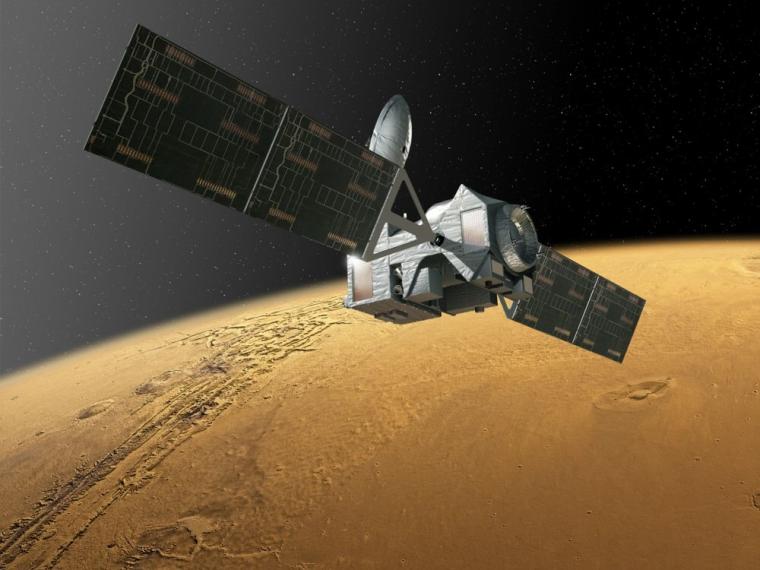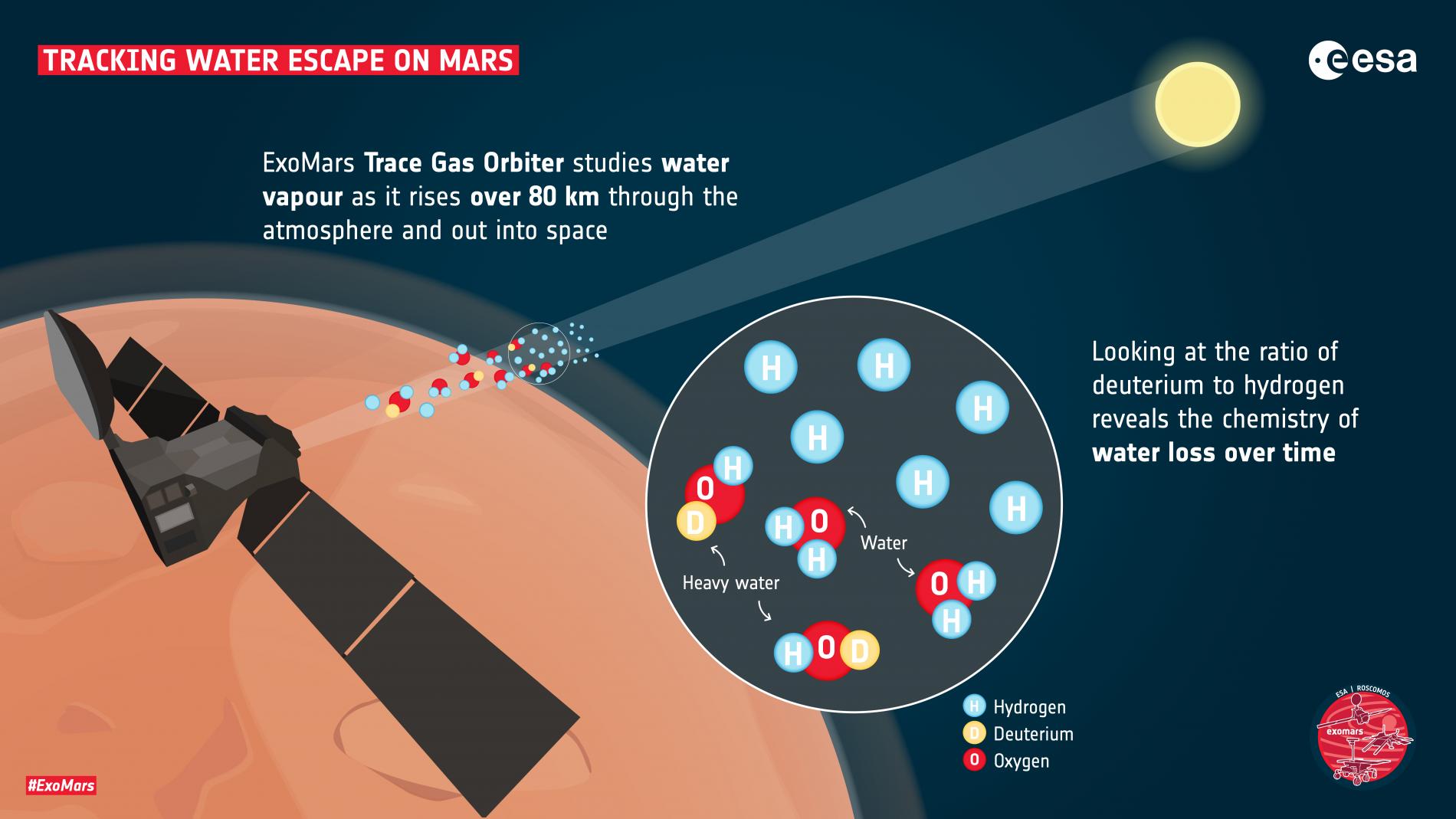ExoMars mission discovers new gas and tracks water loss on Mars
The ExoMars-TGO orbiter, from the European Space Agency and Roscosmos, finds hydrogen chloride in the Martian atmosphere, produced by the release of salt embedded in the planet's surface. The ExoMars data also allow quantifying the loss of water on the red planet and establishing the mechanisms that contribute to the process
Among the main objectives in the exploration of Mars are the search for atmospheric gases linked to biological or geological activity, as well as the development of an inventory of the planet's water, both past and present, to determine if Mars could be habitable and whether any water reservoirs are accessible for future human exploration. Two new results from the ExoMars team, published today in Science Advances and involving researchers from the Institute of Astrophysics of Andalusia (IAA-CSIC), reveal a completely new kind of chemistry and provide more information on seasonal changes and interactions between the surface and the atmosphere.
A NEW CHEMISTRY
“We have discovered hydrogen chloride for the first time on Mars. This is the first detection of a halogen gas in the Martian atmosphere, and it represents a new chemical cycle to understand”, says Kevin Olsen, a researcher at the University of Oxford and one of the scientists leading the discovery.
Hydrogen chloride, which comprises a hydrogen and a chlorine atom, is part of the group of gases based on sulfur and chlorine to which specialists on Mars pay special attention as they are indicators of volcanic activity. However, the nature of the hydrogen chloride observations, detected at very distant locations at the same time and without the presence of other gases associated with volcanic activity, points to a different source. Thus, the discovery suggests a completely new interaction between the surface and the atmosphere, driven by dust seasons on Mars.

Hydrogen chloride, which comprises a hydrogen and a chlorine atom, is part of the group of gases based on sulfur and chlorine to which specialists on Mars pay special attention as they are indicators of volcanic activity. However, the nature of the hydrogen chloride observations, detected at very distant locations at the same time and without the presence of other gases associated with volcanic activity, points to a different source. Thus, the discovery suggests a completely new interaction between the surface and the atmosphere, driven by dust seasons on Mars.
In a process very similar to that observed on Earth, salts in the form of sodium chloride, remnants of ancient oceans evaporated and embedded in the surface of Mars, are lifted into the atmosphere by the winds. Sunlight warms the atmosphere and causes dust to rise, as well as the water vapor released from the polar caps. The salty dust reacts with atmospheric water to release chlorine, which then reacts with hydrogen-containing molecules to create hydrogen chloride. Thus, we would be facing a chemical scenario where water plays a fundamental role, and where there also seems to be a correlation with dust, since more hydrogen chloride is observed when the activity of the dust increases, which in turn is related to seasonal heating of the southern hemisphere.
The team first detected the gas simultaneously in the northern and southern hemispheres during the global dust storm in 2018, and witnessed it disappear, surprisingly quickly, at the end of the dust season. They are currently analyzing the data collected during the following dust season where, again, an increase in hydrogen chloride is observed.

THE INCREASE IN WATER VAPOR AND THE EVOLUTION OF THE MARTIAN CLIMATE
Evidence suggests that liquid water flowed across the surface of Mars in the past, as evidenced by the many ancient dry river valleys and channels. Today water is found in the polar caps and buried underground, and we know that the planet continues to lose water, which escapes into the atmosphere in the form of vapor.
Understanding the interaction of potential water reservoirs and their seasonal and long-term behavior is key to understanding the evolution of the climate on Mars. This can be done by studying water vapor and semiheavy water, in which a hydrogen atom is replaced by a deuterium atom, a form of hydrogen with an additional neutron.
The ratio of deuterium to hydrogen works like a clock, as it tells us about the history of water on Mars and how its loss evolved over time. And ExoMars-TGO can observe the trajectory of different types of water as they rise in the atmosphere in unprecedented detail, since previous measurements only provided the average over the depth of the entire atmosphere. "It is as if before we only had a view in two dimensions, whereas now we can explore the Martian atmosphere in 3D," says Ann Carine Vandaele, principal investigator of the NOMAD (Nadir and Occultation for MArs Discovery) instrument used for this research, and in which the Institute of Astrophysics of Andalusia (IAA-CSIC) participates.
The new data shows that, once the water is completely vaporized, it shows high enrichment in semiheavy water and a deuterium-to-hydrogen ratio six times higher than Earth's in all deposits on Mars, confirming that, with the time, large amounts of water have been lost.
ExoMars data collected between April 2018 and April 2019 also showed three instances that accelerated water loss from the atmosphere: the global dust storm of 2018, a short but intense regional storm in January 2019, and water release from the south polar ice cap during summer months linked to seasonal change. Of particular note is a plume of rising water vapour during southern summer that would potentially inject water into the upper atmosphere on a seasonal and yearly basis.
“The two works certify the magnificent set of instruments that are characterizing the atmosphere of Mars: from the discovery and detection of the presence of hydrogen chloride, in very small but sufficient quantities to be detected and quantified by the ACS and NOMAD instruments, to the characterization and quantification of the escape of water from the planet, even measuring the fraction of heavy water that escapes in relation to the total. This constitutes a very important step to understand the history of the evolution of the atmosphere of Mars, from a denser atmosphere with a greater amount of water to the weak atmosphere that it currently presents”, concludes José Juan López-Moreno, researcher at the Institute of Astrophysics of Andalusia (IAA-CSIC) that participates in the results and in the consortium of the NOMAD instrument.
O. Korablev et al., Transient HCl in the atmosphere of Mars, Science Advances, 10 Feb 2021
G. Villanueva et al. Water heavily fractionated as it ascends on Mars as revealed by ExoMars/NOMAD, Science Advances, 10 Feb 2021.
Instituto de Astrofísica de Andalucía (IAA-CSIC)
Unidad de Divulgación y Comunicación
Silbia López de Lacalle - sll[arroba]iaa.es - 958230676
https://www.iaa.csic.es
https://divulgacion.iaa.csic.es

